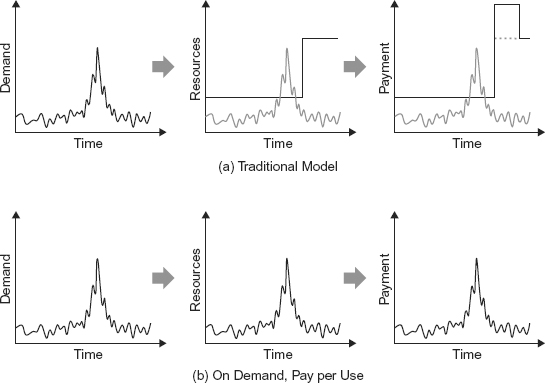Difference from Traditional Purchase and Ownership
Exhibit 5.1 contrasts the on-demand, pay-per-use model of the cloud with a traditional model. As may be seen in Exhibit 5.1(a), as demand varies over time, fixed resources are overprovisioned to serve varying capacity. When a demand spike occurs, there are insufficient resources, leading to lost revenue and poor customer satisfaction and/or lost productivity and poor user satisfaction. By the time a tiger team assembles, does a postmortem, and orders additional capacity, it is too late to serve the spike, and there are now more excess resources than before. Moreover, cash outlays required to purchase and install this equipment lead to an up-front, nonrefundable one-time charge. Depending on the payment structure, the balance of up-front charges and recurring charges may not be exactly as shown, but the point is that, in this model, resources are not aligned with demand, and payment is not aligned with resources.
EXHIBIT 5.1 Traditional versus Cloud Model

As shown in Exhibit 5.1(b), the cloud model has two specific characteristics that align demand, resources, and payment. On-demand resources ensure that exactly the right quantity of resources are available at exactly the right time, which I call perfect capacity, and pay-per-use—that is, usage-based charging—ensures that the financial obligation incurred exactly matches the level ...
Get Cloudonomics: The Business Value of Cloud Computing, + Website now with the O’Reilly learning platform.
O’Reilly members experience books, live events, courses curated by job role, and more from O’Reilly and nearly 200 top publishers.

